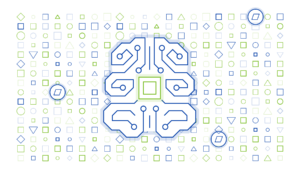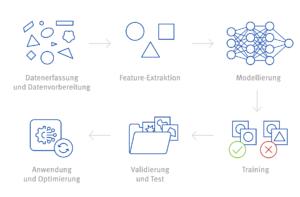What is Artificial Intelligence?
The idea that computers can think and learn on their own is the basic idea of artificial intelligence. Since the invention of the computer, it has been associated equally with great hopes and fears.
In a narrower sense, the term artificial intelligence (AI) refers to computer programs performing certain tasks that require human intelligence. What all these systems have in common is that they analyze large amounts of data in fractions of a second and recognize patterns to draw conclusions and make correct decisions. At the same time, these systems learn on their own to constantly improve. And they do all this much faster than a human could ever do.
How does Artificial Intelligence work?
An AI system can best be thought of as a large number of circuits.
These circuits can process information, recognize patterns, and draw conclusions from them. However, compared to the human brain, AI works much faster and can analyze huge amounts of data in fractions of a second.
An important part of AI is so-called “machine learning”. This means that an AI system learns from experience and gets better and better the more data it processes.
For example, if an AI processes tens of thousands of images of dogs and cats, after some time it can independently recognize whether an image shows a dog or a cat.
Artificial intelligence has the potential to improve many areas of our lives, but there are also ethical issues that need to be considered, such as the responsible use of data and the potential impact on jobs. Overall, artificial intelligence is a fascinating development that will impact our world in many ways.

Classification of Artificial Intelligence
When classifying Artificial Intelligence, a distinction is made between strong and weak AI to describe the level of intelligence and understanding of AI systems.
Weak AI (Artificial Narrow Intelligence – ANI)
Weak AI refers to AI systems that are limited to a specific task or problem. These specific tasks can be solved very efficiently by the AI, but beyond that, they do not have a deep understanding of the context or the ability to operate outside their defined task. These AI systems are referred to as weak AI because they are not able to mimic human intelligence in a wide range of applications or acquire new capabilities on their own.
Strong AI (Artificial General Intelligence – AGI)
Strong AI refers to Artificial Intelligence that can achieve human-like intelligence. This means that a strong AI is capable of handling various tasks, whether they are cognitive, creative, or emotional. Such an AI would be able to learn and improve on its own to develop an understanding of a wide range of topics. Developing such an AI would mean that it would need to develop consciousness, self-awareness, and the ability to make decisions on its own. To date, there is no AI that meets the requirements for strong AI.
Essentially, strong AI differs from weak AI in the level of intelligence and understanding. While weak AI handles specialized tasks, strong AI seeks to achieve a comprehensive intelligence comparable to human intelligence. Strong AI presents additional challenges because it raises many complex technical, ethical, and philosophical questions.
How an artificial intelligence learns
Machine learning (ML) gives computer systems the ability to learn from experience and continuously improve on their own.
Rather than explicitly programming computer programs with fixed rules, machine learning enables them to recognize patterns and structures in large amounts of data and make predictions or decisions based on those patterns.
Machine learning includes techniques such as neural networks, decision trees, and support vector machines. These are machine learning techniques (models) used to classify data points using mathematical formulas and algorithms.
Subdivision of Machine Learning
Data collection and data preparation: In the first step, a lot of data is collected that contains information about the problem or task. This data is cleaned, transformed, and structured to make it usable for the model.
Feature extraction: In the next step, relevant features or properties are extracted from the data. These features represent the input variables that the model will use to make predictions.
Modeling: A model is then created that represents the relationship between the input variables (features) and the output variables (target). There are different types of models, e.g., neural networks, decision trees, support vector machines and many others.
Training: Subsequently, the model is trained with a subset of the collected data. During training, the model adjusts its parameters to provide the best possible prediction for the given data. This is done by constantly comparing the model predictions to the actual results and adjusting the model weights accordingly.
Validation and testing: the trained model is then tested with data it has never processed before to verify its performance and accuracy. This ensures that the model is not only suitable for the training data, but also works correctly with new data.
Application and optimization: Once the model is found to be acceptable, it can be applied in the real world with real data to make predictions or decisions. The model can be further optimized over time by continuously updating it with new data and experiences.

How does Deep Learning work?
Deep Learning is a subfield of Machine Learning and Artificial Intelligence that focuses on processing and analyzing data through artificial neural networks. These networks consist of many layers of artificial “neurons” that can process information and recognize patterns in the data. This is a specialized form of Machine Learning inspired by biological neural networks.
The term “deep” comes from the fact that these neural networks have multiple layers, each representing different features and levels of abstraction. By learning from examples, the weights, and connections between neurons adjust to identify patterns in the data and make appropriate predictions.
Deep Learning has a remarkable ability to identify complex patterns in large amounts of data that would be difficult for humans to grasp. The depth and complexity of these networks make it possible to accomplish tasks at a level that was previously difficult to achieve.
What are Support Vector Machines?
Support Vector Machines are a way of separating or sorting things, like apples and oranges in a fruit store. Suppose you draw a line to separate the apples from the oranges. The goal is to place this line for it to have the greatest possible distance between the nearest apples and oranges.
In AI, SVM helps divide data points into two groups by finding a line that creates the largest possible distance between the two groups. This method is used to classify or separate things. Even if things cannot be easily separated with a straight line, SVM can move them into a space with multiple dimensions to achieve better separation.
The past and future of Artificial Intelligence
The history of Artificial Intelligence dates way back to the 1950s, when the term was first coined. In the early years, the focus was on symbolic or rule-based reasoning, in which computers used human-like rules to draw logical conclusions. In the 1970s and 1980s, expert systems emerged that mimicked the knowledge of professionals in various fields and were used in applications such as medicine and finance.
However, the general expectations for AI solutions were far too high, and most of the goals were not achieved. Due to these disappointments, AI research went through a period referred to as the “AI winter” during which interest in AI plummeted and financial support was significantly cut.
In the mid-1990s, however, AI experienced a renaissance as more powerful computers and larger amounts of data became available. Machine learning, particularly deep learning based on neural networks, led to breakthrough advances in image recognition, natural language processing, and many other applications. This has put AI back in the spotlight and paved the way for current developments and a promising future for AI.
The importance and presence of Artificial Intelligence in our world today is just overwhelming. AI has evolved from a theoretical concept to a key technology that permeates nearly every aspect of our lives. In business, AI plays a critical role in automating tasks and processes. More and more companies are using AI to analyze data, understand customer behavior, provide personalized recommendations, and even take on complex tasks. This can significantly increase efficiency and competitiveness.
Overall, the future of AI will be characterized by innovation, ethical considerations, and new challenges. AI will continue to transform our everyday lives and fundamentally reshape the way we work, communicate, and solve problems. It is important that the development and application of AI be done responsibly to maximize the benefits and minimize the risks.
RELATED TOPICS
Anexia Artificial Intelligence Development →
Anexia Machine Learning Development →
Machine Learning for beginners →
(DE) Förderinitative Artifical Intelligece Mision Austria (AIM AT) →